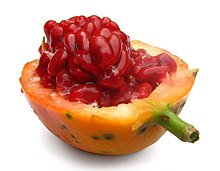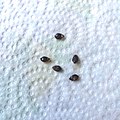Passiflora caerulea
| Passiflora caerulea | |
|---|---|

| |
| Flower in full bloom together with a wilted flower and a yet unopened bud | |

| |
| Fruit cut and opened | |
| Scientific classification | |
| Kingdom: | Plantae |
| Clade: | Tracheophytes |
| Clade: | Angiosperms |
| Clade: | Eudicots |
| Clade: | Rosids |
| Order: | Malpighiales |
| Family: | Passifloraceae |
| Genus: | Passiflora |
| Species: | P. caerulea
|
| Binomial name | |
| Passiflora caerulea | |
Passiflora caerulea, the blue passionflower,
Etymology
The specific epithet caerulea means "blue" and refers to the blue coronal filaments.[7]
Description

Vegetative characteristics
Passiflora caerulea is a woody vine capable of growing to 25 metres (82 ft) high where supporting trees are available.[8] The leaves are alternate, palmately five-lobed (sometimes three, seven, or nine lobes), and are up to 10 centimetres (3.9 in) in length while being linear-oblong shaped.[9] The base of each leaf has a flagellate-twining tendril 5–10 centimetres (2.0–3.9 in) long, which twines around supporting vegetation to hold the plant up.[8]
Generative characteristics
The
Cultivation
Passiflora caerulea is widely cultivated as a wall-climber or as groundcover. Though hardy down to −10 °C (14 °F), it requires a sheltered position facing south or west (in the Northern Hemisphere). It can become invasive, the twining shoots constantly appearing unless eradicated. It has gained the Royal Horticultural Society's Award of Garden Merit.[10]
Cultivars

A number of cultivars have been produced from the species:
- 'Chinensis' (corona filaments paler blue)
- 'Constance Elliott' was raised by Kucombe and Prince in Exeter, Great Britain. It has pure white, fragrant flowers; not as free-flowering as many other clones. It has also won the Award of Garden Merit from the Royal Horticultural Society.[11]
- 'Pierre Pomie', a pale pink flower form
Chemical constituents
Compared to Passiflora incarnata, this plant contains higher amounts of the MAO-inhibitor harmine.[12]
Uses

Though the fruit is edible, it is rather insipid when eaten raw. A tea can be made of the flower or leaves; however, tetraphyllin B and epi-tetraphyllin B,
In South America, the plant is known for its medicinal uses. It is used in both herbal tea and dietary supplements, as well as in marmalades, ice creams, syrups and beverages.[4][6] It is also used by the indigenous Argentinian Toba and Maka people.
Passiflora caerulea is sometimes used as a rootstock, to which is grafted a scion of the edible Passiflora edulis.[13]
The passion flower is the national flower of
Gallery
-
Flower
-
Fruit
-
Flower of Passiflora caerulea
-
'Constance Elliot', a white flowered cultivar
-
'Pierre Pomie', a pale pink flowered cultivar
-
Peculiarity: two fused filaments force anthers upwards, displaying pollen beds otherwise not visible from this perspective.
-
Passiflora caerulea flower
-
The seeds of P. caerulea, the red gel-like substance around them removed
References
- ^ BSBI List 2007 (xls). Botanical Society of Britain and Ireland. Archived from the original (xls) on 2015-06-26. Retrieved 2014-10-17.
- ^ USDA, NRCS (n.d.). "Passiflora caerulea". The PLANTS Database (plants.usda.gov). Greensboro, North Carolina: National Plant Data Team. Retrieved 31 January 2016.
- ISBN 978-1405332 965.
- ^ a b c d Popay, Ian. "Passiflora caerulea (blue passionflower)". www.cabi.org. Retrieved 14 August 2018.
- ^ a b DS Seiglera, KC Spencera, WS Statlerb, EE Connb, JE Dunnb, 'Tetraphyllin B and epitetraphyillin B sulphates: Novel cyanogenic glucosides from Passiflora caerulea and P. alato-caerulea', Phytochemistry, 21/9 (1982), 2277-2285.
- ^ S2CID 86722536. Retrieved 28 August 2022.
- ISBN 9781845337315.
- ^ a b c d "Factsheet - Passiflora caerulea (Blue Passionflower)". keys.lucidcentral.org. Retrieved 14 August 2018.
- ^ a b "Passiflora caerulea: info from PIER (PIER species info)". www.hear.org. Pacific Island Ecosystems at Risk project (PIER). Retrieved 14 August 2018.
- ^ "RHS Plant Selector - Passiflora caerulea". Archived from the original on 7 August 2013. Retrieved 25 May 2013.
- ^ "RHS Plantfinder - Passiflora caerulea 'Constance Elliott'". Retrieved 18 April 2018.
- .
- ^ "Passionfruit". Nellie Kelly. Archived from the original on 25 October 2023. Retrieved 31 October 2023.








